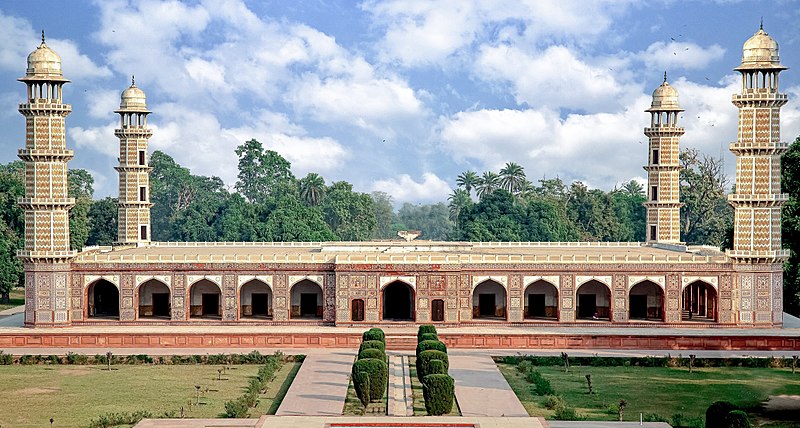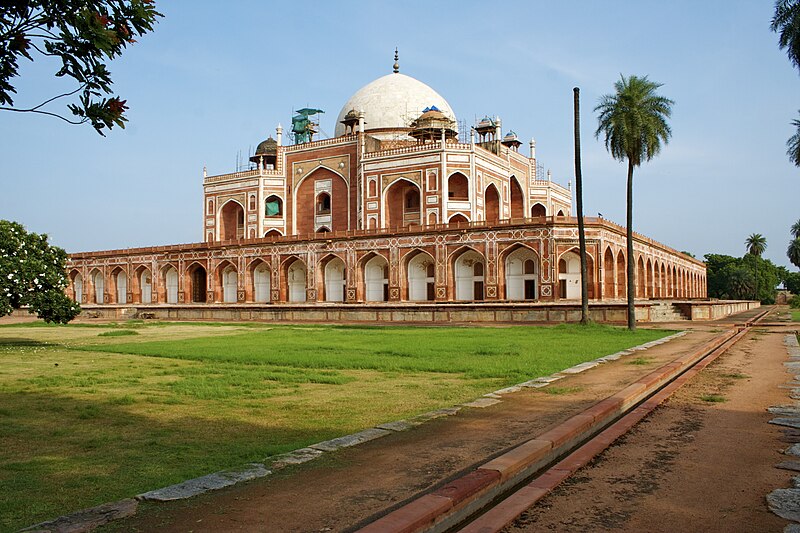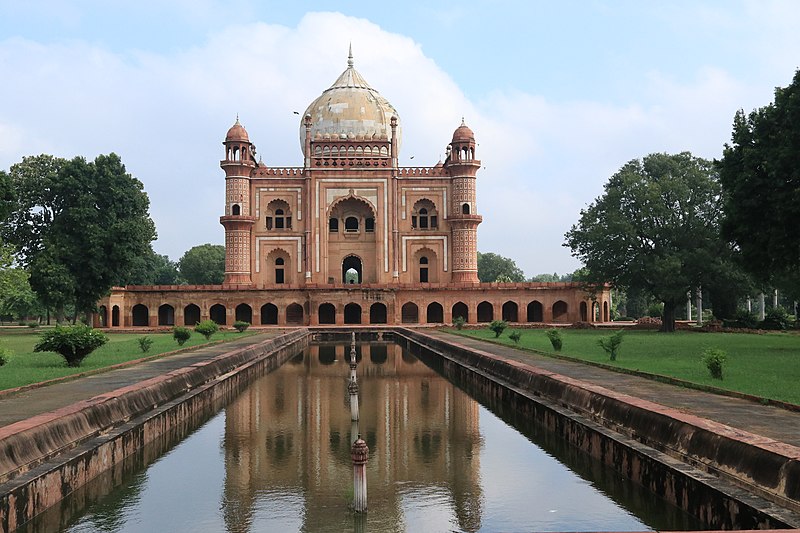Gem of the Month: Mughal Architecture
Aside from painting, architecture is one of the most stunning legacies of the Mughal Empire that ruled most of India between 1526 and (technically) 1857, when it was dissolved by the British East India Company. Technically, the Mughal rulers after the 1750s were puppets of the British EIC. There were nineteen Mughal emperors, but some of the most spectacular monuments were built before the middle of the 1600s, including the fabled Taj Mahal (1632–1647). Some of these monuments were palaces (like the Red Fort, so beautiful), but many were tombs.
 |
| Pakistan, possibly designed by Nurjehan (1577–1645, born Afghanistan), Shahdara, Tomb of Jahangir, 1627–1637, Lahore. Photograph by Tahsin Shah. CC BY-SA 4.0. |
If nothing else, one marvels at elements of art and principles of design while looking at Jahangir’s tomb: line, symmetrical balance, and visual rhythm. Like his grandfather Humayun (died 1556) and father Akbar (1542–1605) before him, Jahangir (1569–1627) broke with Muslim tradition in choosing to glorify himself with a large mausoleum. His wife, Nurjehan (twentieth and final wife of Jahangir), oversaw construction and is thought to have conceived of the design, rejecting the traditional domes. Jahangir’s mausoleum represents a transition in Mughal architecture from predominantly sandstone construction to one incorporating sheets of white marble. Jahangir’s love of color is reflected in the interior and exterior decoration of mosaics in various colors of precious stones. The gardens are also thought to have been designed by Nurjehan. Her design for Jehangir's tomb is thought to have been based on that of her parents, Itimad-ud-Daula in Agra.
 |
| India, Tomb of I'timād-ud-Daulah, lord treasurer of the empire, Agra, 1622. Photograph by Muhammad Mahdi Karim. GNU Free Documentation License. |
Mughal rule had reached its climax under Jahangir and Shah Jahan (died 1666). It is also considered the period during which the arts flourished to their greatest extent. The opulence and luxury of the Mughal court and its arts were unrivaled even among the Safavids in Persia (Iran) and the Ottomans in Turkey. But Persian culture had a strong influence on the Mughal rulers. They adopted the Persian language and forms of script, and imported many artists from Persia.
Nurjehan became one of the most powerful women in the history of Muslim India, having great influence over politics as well as the arts, many of which she practiced herself. Unlike his father, Akbar, Jahangir was not tolerant of Hinduism and Sikh sects.
 |
| Mirak Mirza Ghiyas (Iranian architect), Mausoleum of Humayun, ca. 1560–1570, Delhi, India. Photograph by Ramamanu. CC BY-SA 3.0. |
Humanyun’s tomb was actually built over a site sacred to Vishnu. The buff sandstone alternating with white marble set a trend that led to the all-marble façade of the Taj Mahal. His first wife, the Iranian princess Hamida Banu Begum (1527/1529–1604) is thought to have chosen the Iranian architect Ghiyas.
During the 1700s, with increasing encroachment of the British into India and the weakening of Mughal hold over its vast territory, the age of costly and elaborate tombs came to an end. The Mausoleum of Safdarjang is one of the last examples of the high period of Mughal architecture.
 |
| Bilal Muhammad Khan (Ethiopian), Tomb of Safdarjang, 1754–1774, Delhi, India. Photograph by Yash Raina. CC BY-SA 4.0. |
Safdarjang (Abul Mansur Mirza Muhammad Muqim Ali Kahn, 1708–1754) was a ruler of the state of Oudh under the emperor Muhammad Shah (1702–1748). During Muhammad Shah’s reign, the Iranians invaded India in 1739. Although they soon withdrew, they sacked the Mughal treasury. This may account for the humbler construction of this tomb in local buff sandstone with less marble facing.
It is the last instance of a Mughal tomb using the Iranian Charbagh design, a quadrilateral garden arrangement around the tomb, like the other examples above. The Charbagh layout, a cruciform plan with four paths emanating from the tomb and gardens between each of the paths, was theoretically based on a description in the Qur’an of the four gardens in Paradise.
Correlations to Davis programs: A Global Pursuit 2E: 3.5; A Community Connection 2E: 2.5; Discovering Art History 4E: 4.7, 4.2; Discovering Art History Digital: 4.7, 4.2

Comments